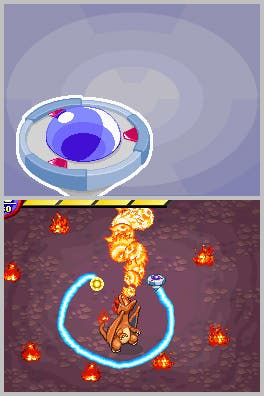Pokémon Ranger
Out of the loop
While we'll gladly defend the proper Pokémon adventures against any and all misguided attacks and insults, we'd find it much harder to do so for many of the loosely related cash-ins that carry the illustrious brand name. Pokémon Channel, Pokémon Dash and Hey You Pikachu all fall firmly into this category of undesirables and while recent DS adventure Mystery Dungeon manages to scrape by simply on merit of its scale, Ranger doesn't do quite so well for itself.
In essence, Pokémon Ranger is simply a game about drawing rings around monsters. Depending on the type, size and power of the creature in question, a larger number of rings will be required to capture it - little Pichu takes but a single circle while Charizard or Steelix can take upwards of twenty continuous loops. And herein lies the tricky part. With the Pokémon constantly moving and attacking to avoid capture, it's not as easy as it sounds to encircle them the desired number of times, especially when there's more than one monster running around the bottom screen. Each reacts differently to the line formed by drawing with the stylus and while some will just speed around to avoid capture and perhaps loose the odd attack, others will go out of their way to try and bust the line. Often, touching a Pokémon will simply break the line and force you to start again but if the line is attacked, the 'styler' (the device used to capture Pokémon) will be damaged and eventually break, causing the dreaded 'Game Over'.

Once you've bagged yourself a few different monsters, you'll be required to put them to work doing tasks that your puny human body can't quite manage. Fire monsters are able to burn down certain barriers, Water types can douse flames or make plants grow and other variants allow you to traverse certain gaps or light up darkened areas. It's a bit like a poor man's Story Of Thor in this respect - if you find a fallen tree blocking your path, you know you'll need to scout the area for a strong Fire type and return in order to continue. Pretty much the entire game plays out in line with this template, making it feel revoltingly straightforward alongside the true Pokémon adventures. But like the superior Mystery Dungeon games, Ranger was never really expected to be a full gaming meal, merely a light snack to keep Pokéhunger at bay until the lavish main courses of Diamond and Pearl, set for release in late April in the US and most likely a couple of months later in Europe.
The real disappointment, aside from the painful hand-holding of the main storyline, is the glint of true potential the game's main mechanic shows at times. Different Pokémon types can be used to alter the capture line in a number of different ways but seeing as only a couple of these are genuinely helpful (even with the type matching system of the real Pokémon games in place), you'll seldom use more than two or three of them. Even some of the battles themselves show promise but with such a basic and restricting mechanic, they have little chance to capitalise on this. Finishing missions allows you to take more allies along with you and use your partner's ability (either Plusle or Minun depending on whether you picked a male or female character) more often and by performing successful captures, the styler can be levelled up for more energy and increased line length. There's even a reduced Pokédex to fill if you can be bothered but with any monster that uses its powers released immediately afterwards, there's no real compelling reason to do so other than for completeness' sake.







